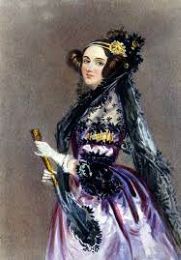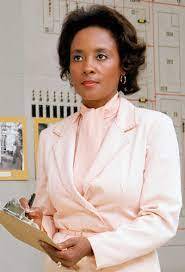

Ada was the daughter of romantic poet, Lord Byron, and his wife, Anna Isabella-Byron. Lady Byron raised Ada to be a mathematician and a scientist. Ada received an excellent education: she was tutored in mathematics by Mary Somerville, and by logician and mathematician Augustus De Morgan.
Her mathematical talent shone through in her early life, and her skills and interest in machines lead to a working relationship with Charles Babbage. Babbage was the inventor of the “Analytical Engine”, a complicated device that was never actually created, but resembled the elements of a modern computer. As a result of her work on the project, Ada is often referred to as the “world’s first computer programmer”. It was Ada’s notes on the Analytical Engine that Alan Turing used as a form of inspiration for his work on the first modern computer in the 1940s.
Ada’s health, which was poor on and off throughout her life, declined further after 1843, limiting her ability to practice mathematics. She died on November 27, 1852, probably of uterine cancer. At her request, she was buried next to her father. Her work remained relatively obscure until 1953, when Bertram V. Bowden compiled Faster than Thought, a history of computers that mentioned Ada’s work and called her a “prophet.”
What we now know about designing and programming computers may not be directly traceable to Babbage and Ada, but they can claim precedence for many of these concepts. And Ada in particular has become a figure whose life and work still stir the imagination of many computer scientists today.

Annie Easley, born in 1933, was an African-American computer scientist, rocket scientist and mathematician who worked for for the Lewis Research Center of the National Aeronautics and Space Administration (NASA).
Annie Easley initially worked as a substitute teacher in Alabama and when she moved to Ohio with her husband, her plans of pursuing pharmaceutical studies fell through. After being inspired by an article Easley applied for work with NASA and worked with them for 34 years.
Easley's efforts in promoting social mobility for the African-American community started as early as 1954 where she helped members of the community study for the literacy test established through Jim Crow laws.
As one of the only four black people (out of 2,500) working for NASA, Easley worked on a multitude of projects, some of her well-known contributions include developing code for NASA's Centaur Rocket and powering early hybrid vehicle battery technology.
As NASA began to replace their "human computers" with technology, Easley went on to learn the programming languages Formula Translating System (Fortran) and Simple Object Access Protocol (SOAP)
Annie Easley later on returned to school to pursue a degree in mathematics in 1977 whilst working full time.
Easley continued her work in promoting diversity and inclusion through her efforts by working with local tutoring programmes to advocate for youth in STEM and as an Equal Employment Opportunity (EEO) counselor where she would address gender, race and age discrimination complaints made by NASA employees.
Annie Easley's work throughout her lifetime built the foundation for future space shuttle launches, satelite development and energy conversion systems research.

Grace Hopper, born on December 9, 1906, was an American computer scientist and naval officer who made significant contributions to the field of technology, particularly in relation to women in tech.
She played a crucial role in the early development of modern computing and was one of the first few women mathematicians and computer scientists to break through gender barriers in a predominantly male-dominated industry.
Grace Hopper actively promoted the inclusion and recognition of women in technology. Her work on the development of COBOL, the first high-level programming language, revolutionized the field by making programming more accessible and user-friendly.
Grace Hopper's achievements were not limited to her technical accomplishments. She actively promoted the inclusion and recognition of women in technology. Throughout her career, she served as a mentor and advocate for women pursuing careers in computing.
Her achievements and dedication to inclusivity continue to inspire women to pursue careers in technology, challenging stereotypes and biases that existed at the time.
Grace Hopper's legacy as a pioneer in computer science and her advocacy for women in tech have had a lasting impact on the industry, empowering women to excel in the field of technology.

Hedy Lamarr is an Austrian-American actress, born on November 9th, 1914. She is also known for her inventions and high contribution in the technology world. She has pioneered and led what would eventually form the basic uses for WiFi, GPS, and Bluetooth communication systems used in today’s era. Lamarr was extremely talented and smart, even from a young age. However, her brilliant mind was often dismissed as her beauty took over, and was later thrusted into the world of acting at sixteen years old. Though she was succesful in this area and enjoyed it, it didn't stop her from being the succesful women she is today.
Her WorkWhen she wasn’t acting, Lamarr would spend her free time testing theories and experimenting with technology. Her first contrubution to the tech world started after meeting (and dating) businessman and pilot Howard Hughes in the early 1950's, where her interest for innovation continued to bloom. Her scientific mind contiued to be fuel whilst working with Huges. He noticed this, and fited her small scientific equipments to use. She started first started setting up and inventing table sets. She was later inspired to help support in building faster planes/models for the US military, and later went on to create an upgraded stoplight. Her innovative and scientific mind continued to grow with her, even during her line in creative work. In 1940, she (along with someone called George Antheil) came up with a new communication system to help the US military guide torpedoes to target their enemies. This 'new and secret comminication system' would later be known as 'Frequency Hopping', which transmitted and received radio waves to find their targets. In 1942, she sought out to patent her new invention and system which was accepted. Her patent (U.S. Patent No. 2,292,387) was later donated to the military and navy by her. However, it was later rejected and dissmed by them, since they believed it wouldn't be worthwhile or deemed important enough.
Awards & RecognitionIt wouldn't be until year later, in 1958, where her genius and inventions would finally recognised properly and began to get credit for her scientific work. Lamarr was awarded the Pinoeer Award (with Antheil) by the Electronic Frontier Foundation for her work on 'Frequency Hopping'. This later led her to become the FIRST women to received the Invention Conventio’s Bulbie Gnass Spirit of Achievement Award in 1977. Lamarr later died in 2000, but was inducted into the National Inventors Hall of Fame, for her system (named ‘Frequency Hoping Technology’) in 2014. Though she never received any money for her inventions whilst she was alive, and wasn’t considered anything serious or more than her beauty and acting background by others till over a decade later, she is now a household name and well-resepcted wormen in the tech world. Due to her genius mind and determination to never give up, she was named 'The Mother of WiFi’. Her invention has continued to support creating systems and devices that we all use, love, and know today, such as: wireless devices, GPS and Bluetooth Systems. Without Lamarr, who knows where technology would be?